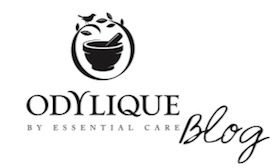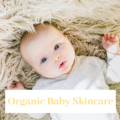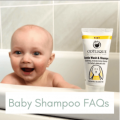
A baby’s skin is thought of as ultra soft, smooth and clear, but did you know that 20% of newborns are affected by baby acne (otherwise known as neonatal acne)?
The appearance of acne is never a welcome one – at any age – and can be a real source of anxiety for parents who are desperate to find out why it has appeared on their child’s skin and how to get rid of it.
What Does Baby Acne Look Like?

Baby acne looks the same as teenage/adult acne- red bumpy spots and whiteheads. Although severity can vary, it is very unlikely your baby will suffer from more severe forms of acne, like cysts.
The severity of the condition can sometimes look as if it has worsened when the skin is aggravated, which can happen when the skin is hot or wet – exposure to breast milk or saliva, in particular, can exacerbate the appearance.
As a general rule, spots can appear on the face, back and chest.
When Can Baby Acne Appear?
If you’re seeing spots within the first 6 weeks of your baby’s life, it is classed as baby acne. If you see spots beyond this, it is classed as infantile acne.
Infantile acne can last for much longer, from a few months up until 2 years of age and requires more action to be taken. If you notice spots lingering for longer than a few months, clarifying whether this is infantile acne or not would be a good first step before treatment is decided.
Baby Acne or Rash?
Diagnosing a skin condition can be confusing; after all, a lot of them look very similar! But without knowing what your baby’s condition is, it’s hard to know how to treat it.
Baby acne is not itchy like other conditions can be (such as eczema), so you shouldn’t notice acne as a source of irritation. It also usually subsides after a few weeks (sometimes up to a few months), while eczema, for example, is more persistent.
Note that acne also doesn’t lay flat; it’s bumpy. It’s not scaly or flaky like a rash.
Neonatal acne and milia often get mistaken for one another. Milia appear as tiny white bumps (1-2mm in size) and look fairly similar to acne. Milia bumps aren’t usually inflamed, so they don’t take on the characteristically red appearance that acne often does.
But if you’re unsure, a professional diagnosis can help clarify.
Baby Acne Causes:
Unlike adult forms of acne, there are far fewer known triggers for acne in babies, and therefore much less you can do about it.
Please remember that if your child has acne, it is not your fault; so don’t feel guilty about it!
Much of the time, baby acne is a short-lived phased that will pass with time.
Hormones In The Womb
It is thought that, because it appears so early on in a baby’s life (up to the first 6 weeks), baby acne is a result of exposure to certain hormones in the womb.
Before the baby is born, hormones from the placenta pass over to the baby to help growth and development. This can stimulate the oil glands in the skin, which (if overstimulated) could cause breakouts.
Food Allergy
Whether you are a breast or bottle feeder, what a baby consumes can affect their skin.
If you are bottle-feeding, you might want to try a different formula to assess the outcome on your baby’s skin. Dairy and soy are common allergens and known to have an impact on the skin and simply switching these out for another option could be the answer you were looking for!
The Baby Acne Breast Milk Connection
Similar to the theory surrounding exposure to hormones in the womb being a trigger for baby acne, hormones in breast milk is thought to be another possible cause. This is why acne can appear worse around the mouth – spots can appear aggravated after coming into contact with breast milk or spit-up.
Breast milk is naturally full of hormones, however, if the mother has an imbalance of hormones herself, the hormone content of her breast milk could reflect this.
One simple thing mothers can do help avoid imbalances is to minimize their exposure to synthetic chemicals (found in cleaning products and skincare for example). Certain chemicals, such as parabens, can mimic estrogenin the body. By using organic skincarelike the products at Odylique, you can rest assured that what you’re putting on your skin is safe, effective and not going to interfere negatively with your hormones.
Remember, it is unavoidable for hormones to be passed onto your baby when breastfeeding and much of the time, this is what is meant to happen! If you can cut the risk of exposure to unnecessary hormones – great, but if not, don’t let this be a source of stress for you at such a special time in your life!
Baby Acne Treatment

Time
In most cases, baby acne will clear up on its own after a few weeks. Because there isn’t much research around the issue, waiting it out is the most sensible thing you can do.
If you find that the acne is persisting, contact a healthcare practitioner to help put your mind and ease.
Natural Baby Skincare
Newborn babies don’t require skincare – washing them in warm water should suffice until they are 3 months old. However, if baby acne turns into infantile acne, setting them up with the best skincare possible is an important consideration.
Lots of parents use moisturising/massaging their baby as a lovely way to bond and relax their little one, especially before bedtime. But have you thought about how your baby’s skincare could be affecting them?
Naturally, you’d assume that skincare for babies is exceptionally gentle. Unfortunately, that’s not always the case. Skincare – even skincare designed for babies – can contain harsh synthetic ingredients that can irritate the skin and make blemishes worse. Some of the ingredients to avoid include sulphates, parabens, fragrance and artificial preservatives.
However, for baby acne, the NHS suggests the use of a mild moisturiser, but how can you be sure that what you’re using is ‘mild’?
…Go organic!
By choosing truly organic skincare (to make sure, check that it’s independently certified), you can be assured that the product is absent from synthetic irritants.
Our Baby Range

The ultra-gentle baby range at Odylique has been specifically designed with even the most sensitive skin in mind, ensuring your baby’s skin is loved, nourished and protected.
Our Baby Repair Lotion can be used all over the face and body to help restore hydration, calm irritation with chamomile and encourage healing with wonderfully soothing aloe juice. It’s also gentle enough to use on sensitive, acne-prone skin.
We also recommend switching the rest of your baby’s skincare to the most natural option. Our dual-action Baby Gentle Wash & Shampoo is a great way to cleanse and balance your baby’s skin and hair, without comedogenic (pore-clogging) ingredients.
Remember, baby acne is thought of as a hormonal condition, so don’t be under the impression that over-washing your baby’s skin is the answer, either.
Although pesky blemishes on your baby’s skin aren’t ideal, there’s really nothing to worry about if they do pop up.
Products Mentioned
 |
 |
| Baby Repair Lotion | Baby Gentle Wash & Shampoo |
Want To Try Our Products?
We only source the kindest ingredients from trusted suppliers who don’t practice unethical or cruel methods of farming, which is why we are able to label every single one of our products cruelty free!
Use code: Babyacne20 at the checkout for 20% off your order! – *Limited to one use per customer*
SHOP BABY PRODUCTS
We also offer a wide range of samples for those of you that would rather try a smaller quantity before purchasing the full item!
SHOP SAMPLES
More Advice
If you’d like more advice on what to do about baby acne or advice on baby skincare, please do email us at customercare@odylique.co.uk, add your question as a comment below, or call 01638 491022 – we’re here to help!
What is Dandruff? How To Beat A Flaky Scalp Naturally.

You take care of your hair; you wash it regularly,…




